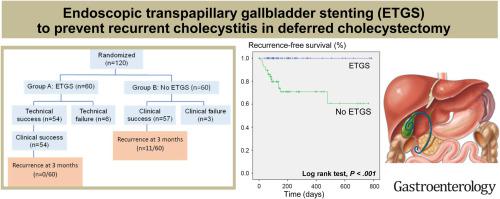当前位置:
X-MOL 学术
›
Gastroenterology
›
论文详情
Our official English website, www.x-mol.net, welcomes your feedback! (Note: you will need to create a separate account there.)
Endoscopic Gallbladder Stenting to Prevent Recurrent Cholecystitis in Deferred Cholecystectomy: A Randomized Trial
Gastroenterology ( IF 29.4 ) Pub Date : 2024-02-14 , DOI: 10.1053/j.gastro.2024.02.007 Wiriyaporn Ridtitid , Julalak Karuehardsuwan , Natee Faknak , Panida Piyachaturawat , Phuphat Vongwattanakit , Santi Kulpatcharapong , Phonthep Angsuwatcharakon , Parit Mekaroonkamol , Pradermchai Kongkam , Rungsun Rerknimitr
Gastroenterology ( IF 29.4 ) Pub Date : 2024-02-14 , DOI: 10.1053/j.gastro.2024.02.007 Wiriyaporn Ridtitid , Julalak Karuehardsuwan , Natee Faknak , Panida Piyachaturawat , Phuphat Vongwattanakit , Santi Kulpatcharapong , Phonthep Angsuwatcharakon , Parit Mekaroonkamol , Pradermchai Kongkam , Rungsun Rerknimitr

|
Endoscopic transpapillary gallbladder stenting (ETGS) has been proposed as one of the adjunctive treatments, apart from antibiotics, before surgery in patients with acute cholecystitis whose cholecystectomy could not be performed or was deferred. Currently, there are no comparative data on the outcomes of ETGS in those who receive and do not receive ETGS. We aimed to compare the rates of recurrent cholecystitis at 3 and 6 months in these 2 groups. Between 2020 and 2023, eligible acute calculous cholecystitis patients with a high probability of common bile duct stone, who were surgical candidates but could not have an early cholecystectomy during COVID-19 surgical lockdown, were randomized into groups A (received ETGS) and B (did not receive ETGS). A definitive cholecystectomy was performed at 3 months or later in both groups. A total of 120 eligible patients were randomized into group A (n = 60) and group B (n = 60). In group A, technical and clinical success rates were 90% (54 of 60) and 100% (54 of 54), respectively. Based on intention-to-treat analysis, group A had a significantly lower rate of recurrence than group B at 3 months (0% [0 of 60] vs 18.3% [11 of 60]; = .001). At 3–6 months, group A showed a nonsignificantly lower rate of recurrent cholecystitis compared to group B (0% [0 of 32] vs 10% [3 of 30]; = .11). ETGS could prevent recurrent cholecystitis in acute cholecystitis patients with common bile duct stone whose cholecystectomy was deferred for 3 months. In those who did not receive ETGS, the majority of recurrences occurred within 3 months. (, Number TCTR20200913001)
中文翻译:

内镜胆囊支架置入术预防延期胆囊切除术中复发性胆囊炎:一项随机试验
对于无法进行或推迟胆囊切除术的急性胆囊炎患者,内镜下经乳头胆囊支架置入术(ETGS)已被提议作为除抗生素之外的术前辅助治疗之一。目前,没有关于接受和未接受 ETGS 的患者的 ETGS 结果的比较数据。我们的目的是比较这两组在 3 个月和 6 个月时复发胆囊炎的发生率。 2020 年至 2023 年间,符合条件的急性结石性胆囊炎患者,胆总管结石可能性高,属于手术候选者,但在 COVID-19 手术封锁期间无法进行早期胆囊切除术,被随机分为 A 组(接受 ETGS)和 B 组(接受 ETGS)。未收到 ETGS)。两组均在 3 个月或更晚时进行了明确的胆囊切除术。总共 120 名符合条件的患者被随机分为 A 组(n = 60)和 B 组(n = 60)。在 A 组中,技术和临床成功率分别为 90%(60 例中的 54 例)和 100%(54 例中的 54 例)。根据意向治疗分析,A 组 3 个月时的复发率显着低于 B 组(0% [60 例中的 0 例] vs 18.3% [60 例中的 11 例];= 0.001)。 3-6 个月时,与 B 组相比,A 组的胆囊炎复发率无显着降低(0% [32 人中的 0 人] vs 10% [30 人中的 3人];= .11)。 ETGS可以预防急性胆囊炎合并胆总管结石且胆囊切除术推迟3个月的患者复发性胆囊炎。在未接受 ETGS 的患者中,大多数复发发生在 3 个月内。 (,编号TCTR20200913001)
更新日期:2024-02-14
中文翻译:

内镜胆囊支架置入术预防延期胆囊切除术中复发性胆囊炎:一项随机试验
对于无法进行或推迟胆囊切除术的急性胆囊炎患者,内镜下经乳头胆囊支架置入术(ETGS)已被提议作为除抗生素之外的术前辅助治疗之一。目前,没有关于接受和未接受 ETGS 的患者的 ETGS 结果的比较数据。我们的目的是比较这两组在 3 个月和 6 个月时复发胆囊炎的发生率。 2020 年至 2023 年间,符合条件的急性结石性胆囊炎患者,胆总管结石可能性高,属于手术候选者,但在 COVID-19 手术封锁期间无法进行早期胆囊切除术,被随机分为 A 组(接受 ETGS)和 B 组(接受 ETGS)。未收到 ETGS)。两组均在 3 个月或更晚时进行了明确的胆囊切除术。总共 120 名符合条件的患者被随机分为 A 组(n = 60)和 B 组(n = 60)。在 A 组中,技术和临床成功率分别为 90%(60 例中的 54 例)和 100%(54 例中的 54 例)。根据意向治疗分析,A 组 3 个月时的复发率显着低于 B 组(0% [60 例中的 0 例] vs 18.3% [60 例中的 11 例];= 0.001)。 3-6 个月时,与 B 组相比,A 组的胆囊炎复发率无显着降低(0% [32 人中的 0 人] vs 10% [30 人中的 3人];= .11)。 ETGS可以预防急性胆囊炎合并胆总管结石且胆囊切除术推迟3个月的患者复发性胆囊炎。在未接受 ETGS 的患者中,大多数复发发生在 3 个月内。 (,编号TCTR20200913001)



























 京公网安备 11010802027423号
京公网安备 11010802027423号